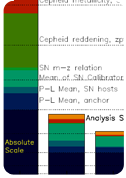We use the Wide Field Camera 3 (WFC3) on the Hubble Space Telescope to
determine the Hubble constant (H0) from optical and infrared observations of
over 600 Cepheid variables in the host galaxies of 8 recent Type Ia supernovae
(SNe Ia), providing the calibration for a mag-z relation of 253 SNe Ia.
Increased precision over past measurements comes from: (1) more than doubling
the number of infrared observations of Cepheids in nearby SN hosts; (2)
increasing the sample of ideal SN Ia calibrators from six to eight; (3)
increasing by 20% the number of Cepheids with infrared observations in the
megamaser host NGC 4258; (4) reducing the difference in the mean metallicity of
the Cepheid comparison samples from \Delta log [O/H] = 0.08 to 0.05; and (5)
calibrating all optical Cepheid colors with one camera, WFC3, to remove
cross-instrument zero-point errors. Uncertainty in H0 from beyond the 1st rung
of the distance ladder is reduced from 3.5% to 2.3%. The measurement of H0 via
the geometric distance to NGC 4258 is 74.8 \pm 3.1 km s- 1 Mpc-1, a 4.1%
measurement including systematics. Better precision independent of NGC 4258
comes from two alternative Cepheid absolute calibrations: (1) 13 Milky Way
Cepheids with parallaxes and (2) 92 Cepheids in the Large Magellanic Cloud with
multiple eclipsing binary distances, yielding 74.4 \pm 2.5 km s- 1 Mpc-1, a
3.4% uncertainty with systematics. Our best estimate uses all three
calibrations but a larger uncertainty afforded from any two: H0 = 73.8 \pm 2.4
km s- 1 Mpc-1 including systematics, a 3.3% uncertainty. The improvement in H0,
combined with WMAP7yr data, results in a constraint on the EOS parameter of
dark energy of w = -1.08 \pm 0.10 and Neff = 4.2 \pm 0.7 for the number of
relativistic species in the early universe. It also rules out the best-fitting
gigaparsec-scale void models, posited as an alternative to dark energy.
\\ ( http://arxiv.org/abs/1103.2976 , 4686kb)
|

![]()